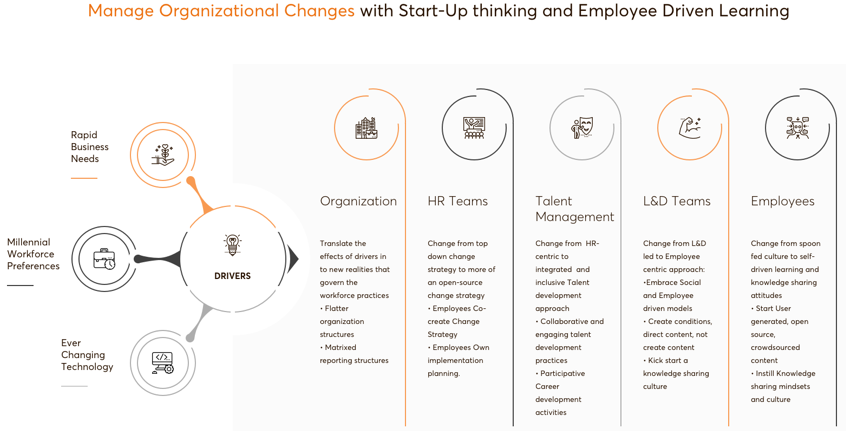In today’s fast-moving economy, change is imperative for organizational success. According to global research and consultancy firm Gartner-CEB’s 2017 white paper, “Making Change Management Work,” an average organization has undergone at least five enterprise changes in the past three years. Everything must be faster, cheaper, employee-centric and workplace supportive.
There are three key drivers fueling these organizational changes:
- Nonstop technological change. Technology continues to unfold at an unprecedented pace. Today’s organizations are faced with a mind-boggling array of new, high-tech possibilities, from robotics and artificial intelligence to cloud-computing and the “internet of things.”
- Millennial workforce. Forbes predicts that by 2025, millennials will account for three-fourths of the workforce. These digital natives expect inclusive, “out-of-the-box,” engaging workplace practices. That will also mean rethinking conventional approaches to on-the-job learning.
- High-speed business needs. Businesses strive relentlessly to meet ever-changing market needs. These needs are fueled by various social and technological factors. To keep their organizations alive, business leaders must adapt to changes as rapidly as they can.
The Ripple Effect of Change Management
These key drivers are having a profound impact on the way organizations operate. The figure below shows how change ultimately trickles down to employees while influencing multiple departments at once.
Gartner-CEB recommends a change management strategy that is open-source and employee cocreated. This participative approach is consistent with our idea of employee-generated learning, which is driven by employees and provides access to diverse expertise. We translate Gartner-CEB’s open-source change strategy (at organizational and HR team levels) into newer practices at talent management, L&D and employee levels.
As organizations become less hierarchical and more open, HR and L&D must embrace inclusive, participative approaches to learning. These approaches encourage employee engagement and productivity; they give employees the freedom to collaborate. Employees can take their initiatives and align their personal career growth with the overall success of the organization.
Employee-driven approaches are not a free-for-all. They require direction and curatorship from L&D professionals who know what it takes for educational content to be effective. The most effective approaches involve a partnership between L&D, HR and employees.
Impact on L&D: Employee-Generated Learning
How can L&D departments adapt to these changes and put employee-driven strategies into action? L&D expert Jane Hart argues that, “L&D professionals need to break free from their traditional roles and relinquish some responsibility — instead of spoon-feeding employees, we should be helping people do things for themselves.”
L&D managers play an important role in enabling employee-generated learning. They should stop creating content themselves and instead start enabling employees (subject matter experts) to do so. In a late 2015 report, Gartner predicted the fast-paced rise of employee-generated learning, stating, “By 2018, more than 80 percent of organizations will leverage user-generated content for their corporate learning strategy to improve employee engagement and increase productivity.” The concept of user-generated content is central to the employee-generated learning model.
There are two things organizational L&D departments can do to get started with employee-generated learning:
- Give subject matter experts the right tools and let them get started.
- Direct the process while letting SMEs do the actual content creation.
This is a modern L&D approach for addressing the new challenges organizations face today. However, it takes creativity and a collaborative mentality to make it work because company leadership must be on board. There may also be resistance to change among employees and a struggle to achieve good quality at first. It takes informed leadership from L&D to get the message across to all stakeholders, to guide and counsel employees and, finally, to champion the change.
Furthermore, employee-generated learning is a democratic solution. To realize its full potential, L&D must effectively combine design (learning needs, content design), technology (IT, infrastructure) and business (HR, talent development, alignment, goals, budget) while also being mindful of strategy, marketing, leadership and other areas of the business. The end goal is to foster a knowledge-sharing culture and ultimately build an internal body of information and resources — build your own Google!
L&D can learn many important lessons from start-up culture. When rolling out an employee-generated learning program, it is helpful for L&D managers to see themselves as product managers. By adopting the product-management process as practiced in today’s cutting-edge start-ups, L&D professionals create a more agile, democratic environment for implementing employee-centered learning. The product they are managing is the learning content that is created by certain employees for other employees to consume. Thinking like a start-up and acting like product managers enables L&D professionals to start operating effectively at the intersection of design, technology and business.
Read part two of this article, “Think Like a Start-Up, Act Like a Product Manager.”
Kasper Spiro is CEO of Easygenerator. Videhi Bhamidi is a product consultant at Easygenerator. To comment, email editor@CLOmedia.com.

















